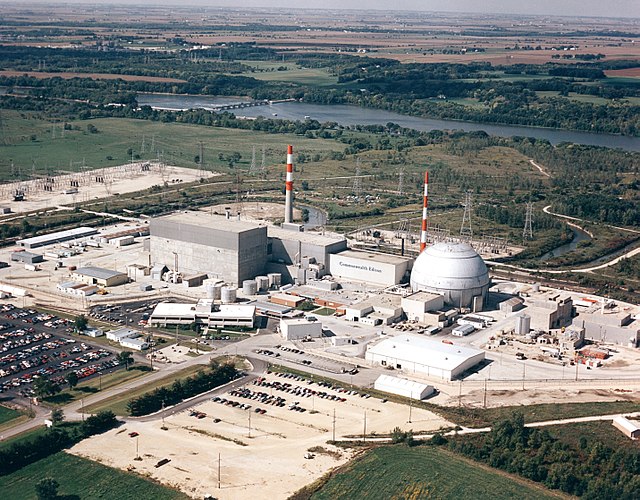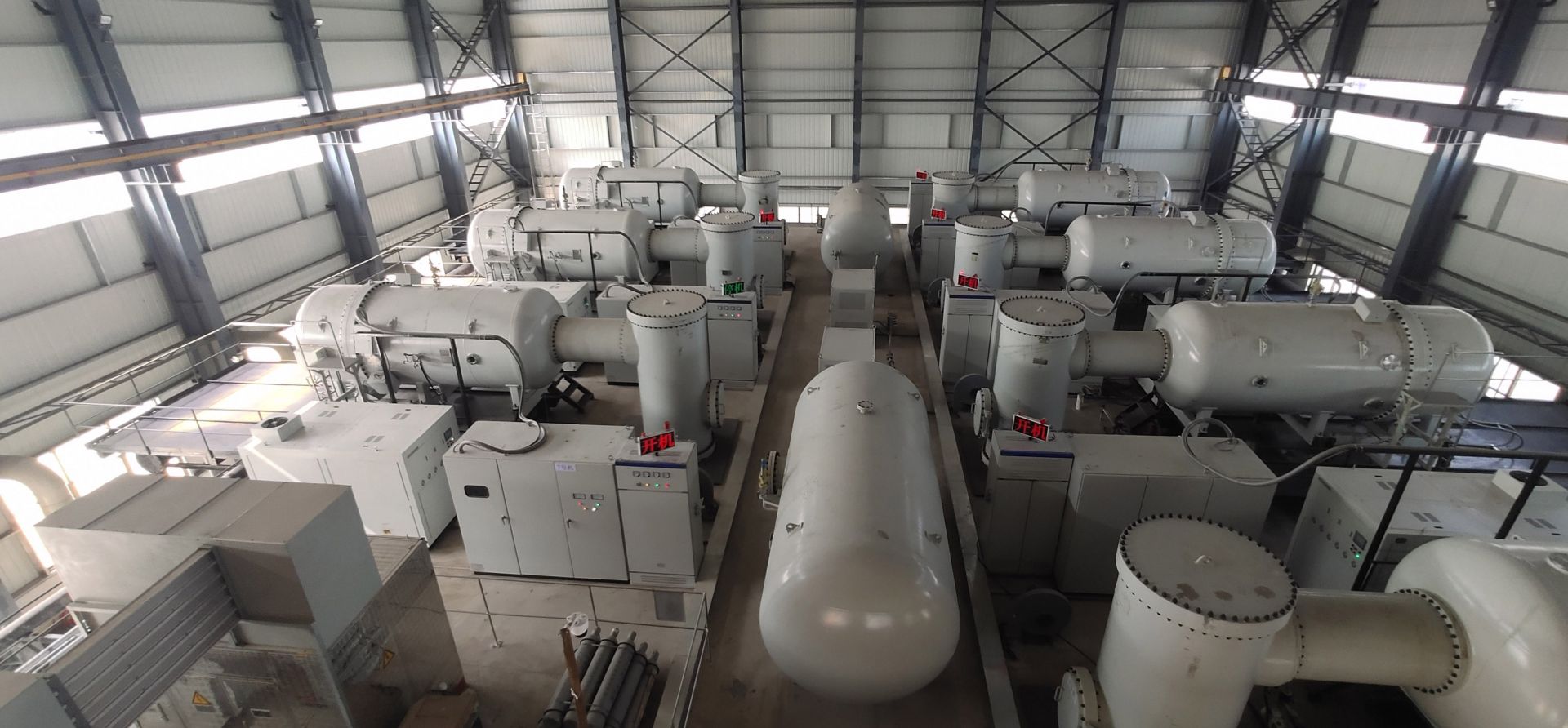A still image from a three-part video tour of NuScale’s facilities. (Photos: NuScale Power)
When Utah Associated Municipal Power Systems (UAMPS) in 2015 announced its plan to develop the Carbon Free Power Project (CFPP) using NuScale Power’s modular light water reactor design, it envisioned the construction of a dozen 50-MWe modules for a plant that could produce a total of 600 MWe. The CFPP’s target output later rose to 720 MWe, when UAMPS opted to scale up to 60-MWe modules. In late June, the plans changed once again, as UAMPS participants chose to build 77-MWe modules but downsize the plant from 12 units to six, which would yield 462 MWe—about 64 percent of the 720 MWe that could have been generated from 12 of the 60-MWe modules.
The Dresden nuclear power plant (Photo: Nuclear Regulatory Commission)
As Illinois lawmakers continue to debate energy legislation that would allow the state’s Byron and Dresden nuclear plants to continue operation beyond this year, Exelon would like to remind everyone—including those legislators, no doubt—of what is at stake.
Nicholas Thompson of LANL helps set up the neutron clustering measurements at the Walthousen Reactor Critical Facility at Rensselaer Polytechnic Institute in Schenectady, NY. (Photo: LANL)
A statistically predicted tendency for neutrons produced inside fission reactors to form in clusters can cause asymmetrical energy production that is counterbalanced, at least in part, by the spontaneous fission of radioactive material in the reactor.
Rendering of the multipurpose building that will house the Nuclear Security Training and Demonstration Centre. (Photo: IAEA)
The International Atomic Energy Agency has broken ground for a new building designed to help countries combat nuclear terrorism in areas such as illegal material trafficking and physical protection of facilities.
July 16, 2021, 3:02PMNuclear NewsCarley Willis and Joanne Liou Photo: Institute of Nuclear and New Energy Technology
With the capacity to treat 30,000 cubic meters of wastewater per day, the largest industrial wastewater treatment facility using electron beam technology in the world was inaugurated in China in June 2020. The treatment process has the capacity to save 4.5 million m3 of fresh water annually—equivalent to the amount of water consumed by about 100,000 people.
Artistic rendering of the Hermes low-power demonstration reactor. (Image: Kairos Power)
Today, Tennessee governor Bill Lee joined Department of Economic and Community Development commissioner Bob Rolfe and Kairos Power officials in Nashville, Tenn., to celebrate Kairos’s plans to construct a low-power demonstration reactor in the East Tennessee Technology Park in Oak Ridge, Tenn. The company first announced its plans to redevelop the former K-33 gaseous diffusion plant site at the Heritage Center, a former Department of Energy site complex, in December 2020.
Taishan’s Unit 1 was the world’s first EPR to be connected to the grid. (Photo: CGN)
The facts, once known, were uncomplicated. At Taishan-1 in China—the first Framatome EPR to be commissioned—operators detected an increase of fission product gases within the primary coolant circuit sometime after the reactor’s first refueling outage in October 2020. The cladding on a handful of the more than 60,000 fuel rods in the reactor had been breached, posing an operational issue—but not a public safety issue—for the plant.
Sequoyah nuclear power plant (Photo: Photorush/Wikimedia Commons)
In an evaluation report released last week on the Sequoyah nuclear plant’s chemistry/environmental program, the Tennessee Valley Authority’s Office of the Inspector General identified certain risks, both behavioral and operational, that could impact organizational effectiveness. Program behavior was assessed from interviews and field work conducted from September 21 through November 3, 2020, with operations assessed in February of this year.
Map of the PJM Interconnection territory in dark blue. Image: PJM
PJM Interconnection’s board of managers has approved the grid operator’s proposal to address the Federal Energy Regulatory Commission’s controversial December 2019 minimum offer price rule (MOPR) order affecting PJM’s forward-looking capacity auctions. (PJM operates the largest wholesale competitive electricity market in the country.)
The hemicycle of the European Parliament in Strasbourg. Photo by DAVID ILIFF.
Eighty-seven members of the European Parliament sent a letter to the European Commission last week to lobby for the addition of nuclear energy to the EU taxonomy, the purpose of which is to direct investments toward environmentally sustainable economic projects to meet the European Union’s climate change mitigation and energy-mix targets.
Training for the realities of radiological incidents and emergencies
July 9, 2021, 2:43PMNuclear NewsGreg White, Steve Kreek, William Dunlop, Joshua Oakgrove, Dan Bower, Dave Trombino, Erik Swanberg, and Steven Pike One of the biggest challenges in training for incidents and emergencies that involve high-radiation-dose hazards is balancing between realism and safety. To be truly prepared for the realities of real-world nuclear and radiological emergencies, responder personnel need experience against those hazards but without introducing additional and very personal risks associated with unnecessary radiation exposure. The difficulty is in figuring out how we can achieve a level of realism that encompasses the entire process, from the initial detection of a hazard or threat, through its characterization, to recommending actions and leadership decision-making.
Flags in front of the European Commission building in Brussels. (Image: Sébastien Bertrand)
The European Commission last week adopted the Euratom Work Programme 2021–2022, implementing the Euratom Research and Training Programme 2021–2025, a complement to Horizon Europe, the European Union’s key funding program for research and innovation.
Map of ERCOT over the state of Texas (Image: ERCOT)
Motivated by February’s Texas grid debacle and last month’s Electric Reliability Council of Texas (ERCOT) alert pleading with residents to conserve energy, Gov. Greg Abbott earlier this week issued a letter to members of the Public Utility Commission of Texas (PUC), directing them to take immediate action to improve electric reliability across the state. According to the governor’s office, the directives build on reforms passed in the 87th legislative session to increase power generation capacity and ensure the reliability of the Texas power grid.



















.jpg)
